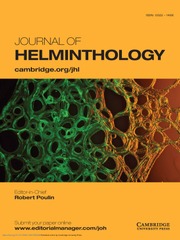Article contents
Detailed characterisation of the Co-Smad protein in liver fluke Fasciola gigantica
Published online by Cambridge University Press: 06 January 2025
Abstract
Fasciolosis, caused by the liver flukes Fasciola hepatica and Fasciola gigantica, is a zoonotic parasitic disease associated with substantial economic losses in livestock. The transforming growth factor-beta signalling pathway is implicated in developmental processes and biological functions throughout the animal kingdom, including the Fasciola spp. It may also mediate host–helminth interactions during infection. In this work, we present an exploration of FgSmad4, the sole member of the Co-Smad protein family in F. gigantica. The isolated FgSmad4 cDNA was 4,014 bp in length encoding for a protein comprising 771 amino acids. FgSmad4 exhibited typical Co-Smad protein features, including Mad Homology 1 (MH1) and Mad Homology 2 (MH2) domains, a Nuclear Localisation Signal, a DNA-Binding Motif, and a Nuclear Export Signal. Sequence and phylogenetic analyses of FgSmad4 revealed that its MH1 and MH2 sequences are most similar to those of other trematode species. The MH1 domain, in particular, closely resembles the Co-Smad protein in mammalian hosts more than those in cestodes and nematodes. The expression patterns of FgSmad4 during the liver fluke’s developmental stages showed significant variation. Transcript levels were highest at the newly excysted juvenile stage, followed by unembryonated egg, redia, and metacercaria, with the lowest expression in the adult fluke, embryonated egg, and cercaria stages. Our results underscore the conservation and suggest the potential role of FgSmad4, a key transforming growth factor-beta signalling molecule within the liver fluke F. gigantica. As Co-Smad is typically involved in several biological pathways, the precise functions and mechanisms of this identified FgSmad4 necessitate further exploration.
Keywords
- Type
- Research Paper
- Information
- Copyright
- © The Author(s), 2025. Published by Cambridge University Press
References
- 1
- Cited by


